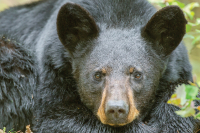A peek at the watershed
One hundred and twenty people or so took advantage of Waynesville’s first Watershed Appreciation Month to see and learn more about the town’s 8,600-acre watershed. The program ran the last three Saturdays in April and included hikes and presentations in the watershed plus programs at town hall.
Program participants got watershed mud on their boots during a water quality monitoring hike, forest conditions hike, and birding and natural history hikes. The Haywood Waterways Association presented programs on site and at town hall and Christie Fulcher, a graduate student at Western Carolina University, presented a program on Quinlantown — a small logging community deep-sixed now beneath the town’s reservoir.
Ron Moser of Haywood Waterways presented a program at the watershed on April 21 and Gordon Small, a member of Haywood Waterways board of directors, gave a presentation at town hall on April 28.
Dr. Peter Bates and Dr. Jerry Miller of WCU led the water quality and forest conditions hikes. Yours truly led the birding hikes and, with help from Peter Bates on the 21st and Ed Kelley on the 28th, facilitated the nature hikes. Rusty Painter, land protection director for The Conservation Trust for North Carolina, which oversees the watershed’s conservation easement, joined us on the 28th.
The Easter cold snap slowed migration this spring and on our first birding walk (21st) we had as many winter residents as we did spring arrivals. Those winter residents included white-throated sparrow, golden-crowned kinglet, ruby-crowned kinglet, yellow-rumped warbler and red-breasted nuthatch. Spring migrants on the 21st included black-and-white warbler, black-throated green warbler, black-throated blue warbler, ovenbird and blue-headed vireo. By the 28th, blackburnian warblers, hooded warblers, yellow-throated vireos and red-eyed vireos had joined the crowd.
Related Items
The cold snap also but a damper on the spring wildflower show, doing in many of the early bloomers like bloodroot and spring beauty and delaying others. Blooms were really scarce on the 21st. We discovered one bloodroot, a few violets some toothwort, a couple of wild oats, a jack-in-the-pulpit and some creeping phlox. The 28th was a little better with wild geraniums, showy orchis, a few trilliums, some anemones and mandarin among others added to the mix. We took a couple of minutes to turn stones in the creek and came up with a seal salamander on the 21st and a mountain dusky on the 28th.
Hikers experienced different habitats depending on which hike they took. Some of the ecosystems explored included white pine and mixed hardwoods, Appalachian cove forest and montane oak-hickory forest.
A great big thank you to Alison Melnikova of the town of Waynesville for orchestrating Watershed Appreciation Month. Bates, who is also part of the watershed management team, was pleased with the turnout and I think the two may have their heads together making plans for more public outings in the watershed.
The possibilities for environmental education in the watershed are boundless, and the town appears to be working in the direction of more public access and outreach. As part of the management team, Bates was happy to see so many citizens eager to learn more about their watershed. “It helps take the mystique of the watershed away,” he said. The more people learn about the watershed and its resources the easier it will be for the town and the management team to come up with good stewardship policies.









